Unplugged: Euthia: Torment of Resurrection (Boardgame)
 If there are any Holy Grails in the boardgaming world, it is to find the perfect civilization-building boardgame and the perfect dungeon-crawl/RPG boardgame. Euthia has nothing to do with civilization-building but is a worthy attempt at an RPG style adventure boardgame. Players take on the role of one of several possible heroes and explore a world created by revealing modular map tiles. Over the course of the game heroes will search (or mine) for treasure, go on minor quests, enlist the help of elementals, and (of course) fight monsters. Unlike many games in the genre, each game of Euthia is a one-and-done experience with no need to pack away bits and bobs in order to preserve a specific character for the next exploration. It is nice to have a nice, epic arc of character progression in a single sitting but that does mean a single game can take a good amount of time. There are several scenarios included with the game varying in length from 30 to 100+ minutes PER PLAYER. Thankfully, a 2 player game is quite do-able. For those willing to put in the time, Euthia provides a great, complete RPG/exploration experience in a single sitting, unlike the modern trend of stringing out a good bit of hero/character development over the course of a half-dozen (or more) individual, but linked, plays of a game. An expansion/continuation of the game is currently on Kickstarter until May 16th.
If there are any Holy Grails in the boardgaming world, it is to find the perfect civilization-building boardgame and the perfect dungeon-crawl/RPG boardgame. Euthia has nothing to do with civilization-building but is a worthy attempt at an RPG style adventure boardgame. Players take on the role of one of several possible heroes and explore a world created by revealing modular map tiles. Over the course of the game heroes will search (or mine) for treasure, go on minor quests, enlist the help of elementals, and (of course) fight monsters. Unlike many games in the genre, each game of Euthia is a one-and-done experience with no need to pack away bits and bobs in order to preserve a specific character for the next exploration. It is nice to have a nice, epic arc of character progression in a single sitting but that does mean a single game can take a good amount of time. There are several scenarios included with the game varying in length from 30 to 100+ minutes PER PLAYER. Thankfully, a 2 player game is quite do-able. For those willing to put in the time, Euthia provides a great, complete RPG/exploration experience in a single sitting, unlike the modern trend of stringing out a good bit of hero/character development over the course of a half-dozen (or more) individual, but linked, plays of a game. An expansion/continuation of the game is currently on Kickstarter until May 16th.
Euthia: Torment of Resurrection
Publisher: Steamforged Games
Players: 1-4
Ages: 14+
Time: 60-480 min
(review copy provided by publisher)
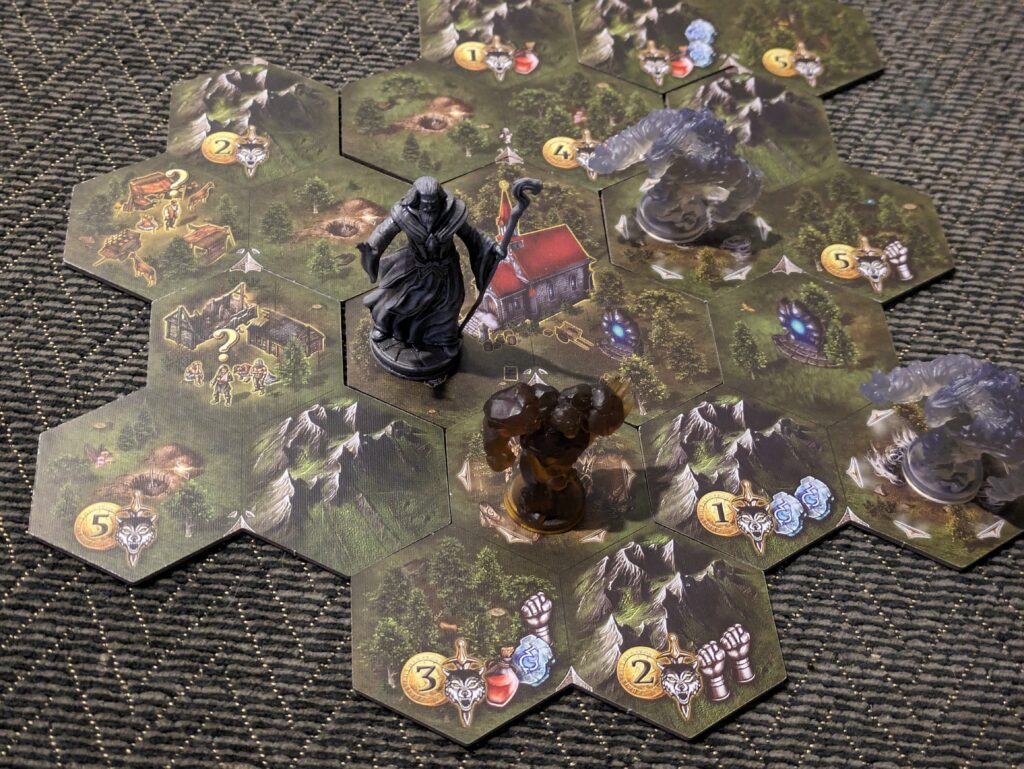
The flow of the game
Euthia has players roaming around a game board built up from y-shaped hexagonal tiles. These tiles provide a wealth of opportunities. Heroes can collect treasures just by passing over a treasure hex, “mine” mountain/lake/cave hexes, warp around the board via portal hexes, purchase items from various vendor hexes, acquire quests from encounter hexes, and interact/defeat elementals on their home hexes. Of course, there are monsters to fight, and most hexes have a resident monster that must be defeated before taking advantage of the interaction with the underlying hex. In general, the first player to interact with a hex has an advantage, most hexes can be used by subsequent heroes if a small 1-coin tax is first paid to the initial explorer.
Movement is accomplished through an ingenious trade-off with actions. Players have three tokens representing mining, purchasing, and combat that must be spent in order to perform those actions. However, those tokens are also used for movement (one,two,three respectively) so a player needs to weigh moving around the board against taking the interesting actions. Players can defer one of their tokens to the next round, giving them four different tokens to use if they are planning for something big. If players head out on their own trajectories the players can easily get far apart on the board. Here, the portals are great as it is free to move between them and prevents players from getting stuck in a particular area – avoiding boring turns where one only spends one’s tokens for movement.
There are many ways to improve one’s hero aside from combat but combat is still going to be an important part of the game. Combat is resolved in a fairly common manner with the monsters attacking with a roll of two dice checked against their stat card and then the player attacking with two dice checked against their weapon of choice. What is more unique is how one’s opponent will take control of the monsters during combat. During the game, players slowly accumulate gauntlet cards (silver and gold – the gold are more powerful) which can help the monsters attack or hinder the hero’s attack. Every combat begins by giving the defending player (not the attacking hero) one or more chaos tokens. These can be spent to play a player’s gauntlet cards against the hero. These may increase the monster die roll, decrease the hero’s die roll, add in additional damage, etc… If a player is particularly rich in gauntlet cards, they can play a matching pair along with the chaos token in order to play an upgraded version of the card. Players on both sides (monster and hero) also have Gaar tokens which give a reroll and a +2 bonus to their side. These are somewhat precious so the monster player needs to think carefully whether to spend some against another player or keep them to help them out in their own hero combats.
The game has a competitive and a solo/co-op mode of play. Competitive games have players attempting to earn the most reputation points. These points are the primary gauge of a hero’s level of power and essentially serve as experience points. These points are earned through most encounters (mining, questing, defeating monsters) during the game. However, there is also a game-end scoring phase where players earn additional reputation for interacting with hexes during the game – things like mining, opening trading posts, looting treasures, questing, and defeating particularly nasty elite monsters. Cooperative/solo games still use Gauntlet cards, which accumulate over time. During combat, the monster does not roll dice but a card from the solo monster deck is flipped to reveal the dice “rolled” as well as any additional effects. Gauntlet cards from the stack are then “played” against the player and combat otherwise resolves as normal.
The game has several possible scenarios spanning the 30 minute per player introductory scenario all the way up to the capstone scenarios against the big-bad-evil guys that can run over 100 minutes per player. While that seems like a lot, I suspect players familiar with the game can trim that time down a bit – but it will still be a lengthy game. Longer scenarios will have the benefit of letting the players’ characters develop into much more powerful versions of themselves, so there is a trade-off to be made.
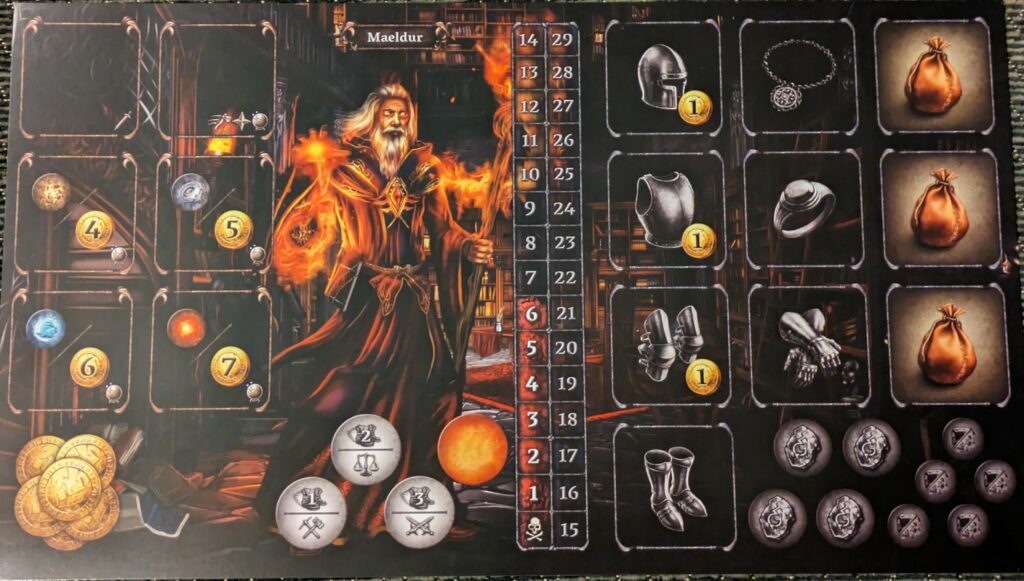
Heroes
Speaking of heroes, the game contains six heroes with a broad range of abilities to provide different play styles. All heroes share some basic attributes which are tracked using that particular hero’s character sheet. Most game abilities/weapons are represented by tiles. On the mat there are tile places for weapons, abilities, armor, and special items. Players have a 3 slot backpack for carrying things but that can even shrink when wearing particularly heavy equipment like armor. The right side of the sheet is generally found or purchased equipment while the left side is where players will place their heroes special abilities. As heroes level up in reputation, they unlock new abilities. These abilities almost always come in pairs. Only one can be selected so a specific character could have a different style of play from one game to another. These abilities may be new weapons or combat abilities, but they could also be powerful non-combat abilities – like special movement options or the option to find “treasure” in locations that have already been claimed by the other heroes. One cannot just fill up the player mat at will. Most of the slots also require a payment (money or special resources) to open, after which players may fill them up with acquired tiles.
In addition to what’s already been mentioned there are a few additional mechanics floating around – gems to upgrade items, armor sets for bonuses, a luck-mitigating die that sometimes comes into play during a combat, board effects produced by adjacent elementals, and (usually) some unique effects that come into play at the end of each of the scenarios. One thing I have not yet covered is player death. Player death is actually quite “friendly.” There’s very little penalty (not even ending one’s turn) beyond granting the monster-controlling player a few bonus points at the end of the game. Death by combat is the most common but if a hero manages to die outside combat there are slightly fewer benefits and a loss of two Reputation for being such a knucklehead.
Verdict:
There is a lot to love here and one big thing to dislike. That one thing is simply the amount of time it takes to play a satisfyingly complete game. By satisfyingly long, I’m looking at a game where a player gets above 20 reputation so some of their more powerful abilities start to kick in and more interesting equipment can be acquired. However, the journey along the way is engrossing. I like how monster combat pits one player directly against another, forcing both of them to weigh the cost of escalating the fight. This does make combat more complex but I think it is a good trade-off. Character improvement is satisfying. Early levels often add in interesting new abilities like new movement or board-interactions rather than simple modifications to combat. Monsters come in three levels and may also be elite. it may just be me, but the jump from level 1 monsters to level 2 monsters was quite a leap. In shorter scenarios I was hard pressed to get upgraded enough to put up a good fight. Fans of the role-playing side of games of this ilk will find the six different heroes available, each of which have two choices for each upgrade, offering a lot of character options to explore. Unfortunately, the early and mid-game parts of most scenarios are similar – relying on the variation of revealed quests and equipment to change from game to game. Using different heroes in each game will help to make those early turns more unique.
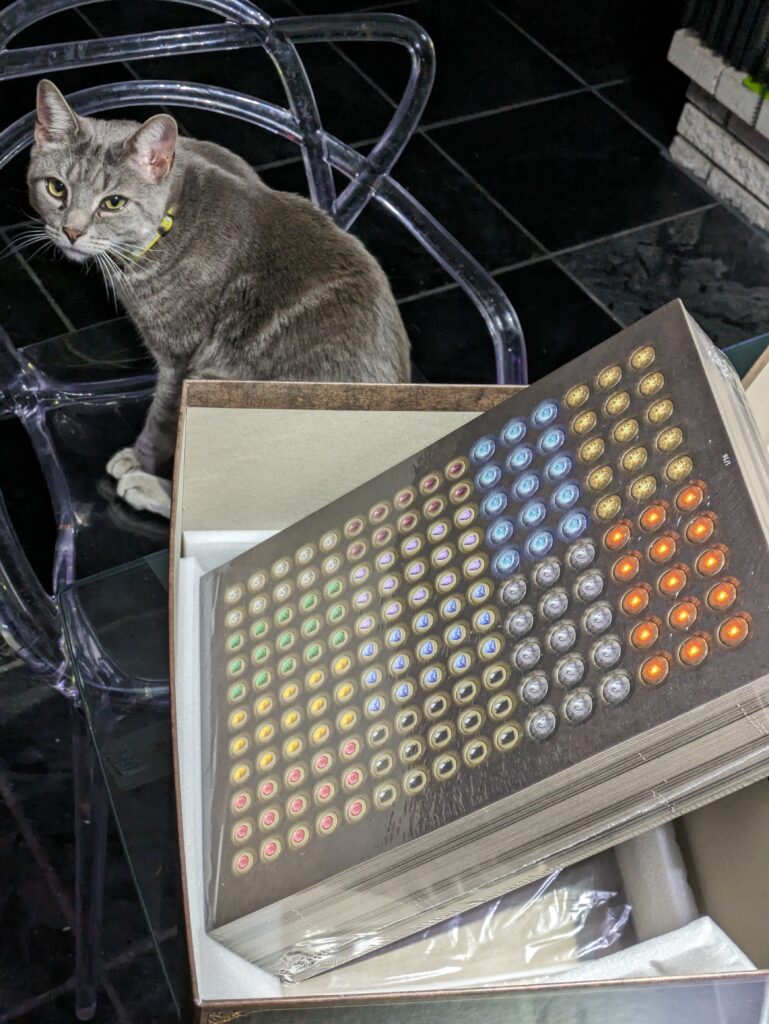
Even punching the cardboard pieces takes a long time. Our cat was patiently waiting to use the box…
The time requirement for some scenarios may look scary and they do require a large commitment, especially with higher player counts. However, this is only one way to look at things. This is a one-and-done sort of game. Every scenario is a complete game, taking one’s hero from low levels up to the highest level in a single sitting. Many RPG-ish games rely on multiple linked scenarios to provide character growth. This requires multiple sessions that can easily be strung together to require far more game time.
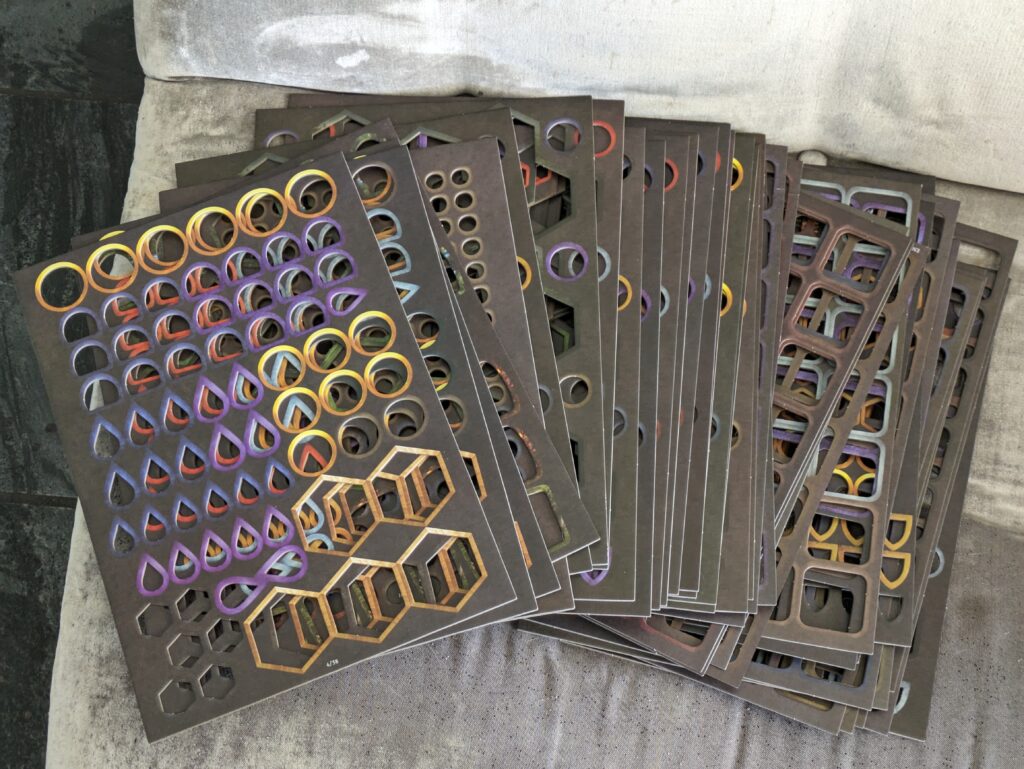
Look, I managed to get all the pieces punched!
Overall, I enjoy the game and look forward to checking out some of the other scenarios and hero types. Most of the level-improvement choices steer a character towards one strategy or another. Choosing a different early upgrade power will change many decisions further down the line. However, that time commitment issue is always going to be something to overcome. I doubt I will attempt any of the longer scenarios with a full complement of four players. This is a trade-off though. Similar games in this vein are put together in a linked series of scenarios that may take an hour (or more) each, adding up to a far larger time commitment overall. Having one “big” game also allows a nice steady pace of hero improvement. Rather than try to dribble in improvements between linked scenarios, I get to level up my character over the course of a single evening/afternoon. It is far more likely that I will set up and complete one of the longer scenarios than make my way through one of the many campaign based RPG-style games out there.
While I’ve only played the base game, there’s one expansion available as well as a second expansion (proclaimed the “epic final chapter” of the trilogy) now up on Kickstarter until May 16th.
- heroes and bosses
- All the elementals
Kid Factor
This game is not for kids. There is a LOT going on. I think the 14+ age range is fine but could go a bit lower for kids who are experienced with more complex games. There isn’t a huge reading problem as anyone able to follow along with the various goings-on is probably going to be fine at reading the necessary instructions. There isn’t much in terms of gore, risque content, or particularly disturbing evil situations, so if a kid can handle the rules set and the time commitment they will be fine.

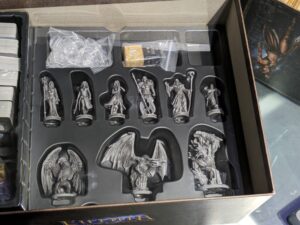
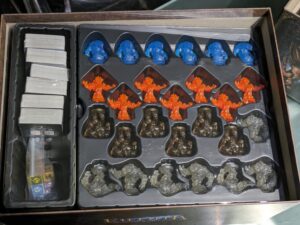




Discussion Area - Leave a Comment